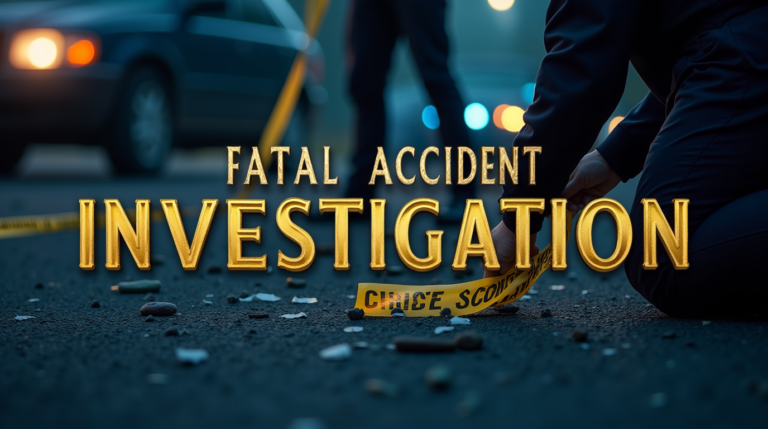The silence after a fatal crash is filled with unanswered questions. In 2021, 42,939 lives were lost on U.S. roads. Each life cut short, each family forever changed. As a professional in fatal accident investigation, you have a critical role.
You uncover truth, understand causes, and aim to prevent future tragedies. Crash analysis is more than a technical task. It’s a deep commitment to justice and safety.
Your work turns tragic moments into chances for prevention. It helps communities understand and reduce risks that threaten lives.
This guide will give you key strategies for thorough fatal accident investigations. You’ll learn how to assess scenes, analyze evidence, and reconstruct events. You’ll also learn how to collect evidence and develop insights that can save lives.
Table of Contents
Understanding Fatal Accident Investigation Fundamentals
When you start a fatal accident investigation, you need a detailed plan. It’s not just about what happened. You aim to find the main causes and stop similar accidents from happening again. This is done by collecting evidence carefully and reconstructing the accident.
Experts say most workplace deaths could be avoided. The investigation is key to spotting risks and making places safer.
Defining Investigation Scope and Objectives
At the start, you must set clear goals for the investigation. These goals are important:
- Finding out exactly what happened
- Spotting what led to the accident
- Looking at ways to prevent it in the future
- Keeping detailed records of evidence
Legal Requirements and Compliance
Following the law is essential in accident investigations. Groups like OSHA have rules for how to investigate. Your work must follow these rules and use strict scientific methods.
Key Stakeholder Identification
Good investigations need teamwork. This includes:
- Police and other law enforcement
- Insurance people
- Lawyers
- Safety experts
Each team member adds their own skills. Together, they help understand the accident fully.
Initial Response and Scene Management
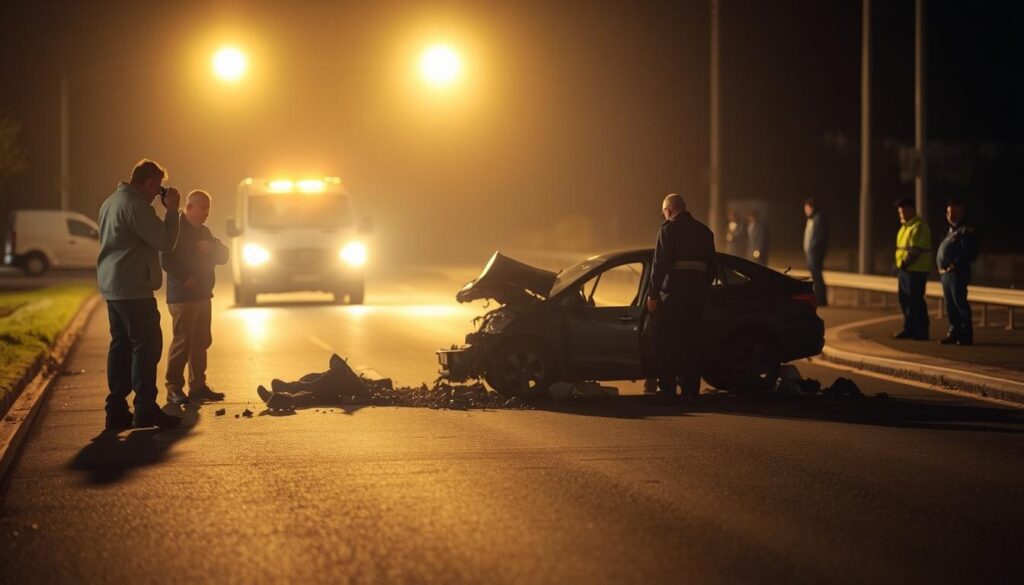
When a fatal accident happens, how you respond first is key. Documenting the scene is vital to understand what caused the accident. Emergency teams must act fast and follow a plan to keep evidence safe and everyone safe.
The first hour after an accident is called the “Golden Hour.” It’s when you need to:
- Secure the accident area
- Stop other accidents from happening
- Keep evidence safe
- Make sure responders and the public are safe
Traffic Incident Management (TIM) teams are important in handling accidents. They use special steps to keep everyone safe and the scene intact. Studies show that the right lights and signs on emergency vehicles help drivers see better and stay safe.
| Response Priority | Key Actions |
|---|---|
| Safety | Deploy warning signs, use reflective gear |
| Evidence Preservation | Minimize scene disturbance, mark critical areas |
| Medical Response | Rapid victim extrication and transport |
Investigators must carefully move vehicles, keep evidence in place, and get ready for detailed documentation. By sticking to a plan, you can do a complete and accurate investigation. This helps figure out what happened and supports legal actions.
Evidence Collection and Documentation Methods
Forensic evidence collection is key in fatal accident investigations. Your skill in gathering and documenting evidence is crucial. In Texas, where 4,283 vehicle-related fatalities happen each year, detailed scene documentation is vital.
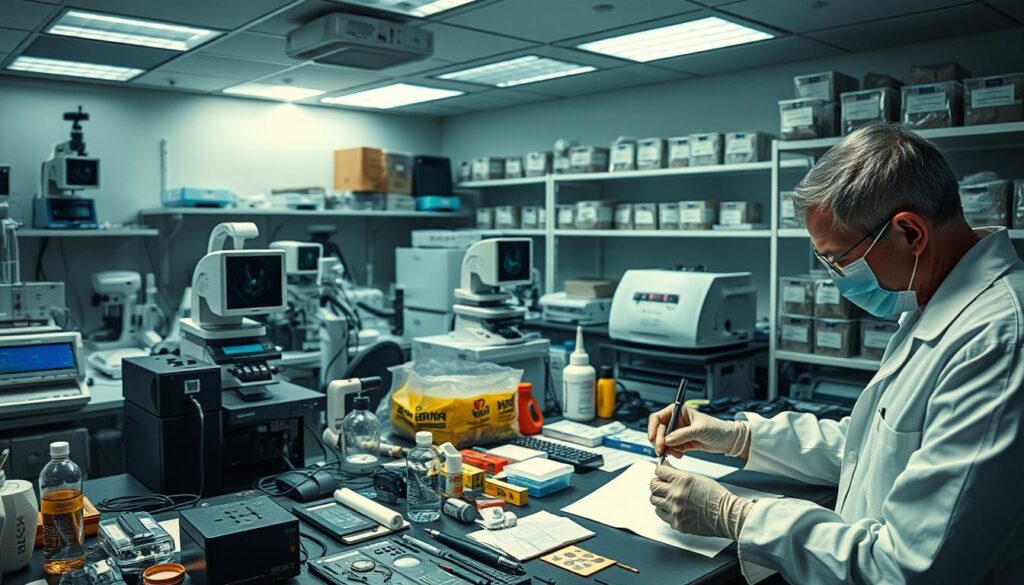
To collect evidence well, you need a solid plan. Investigators must be careful and detailed in their work. Here are some ways to ensure you gather all the evidence you need:
- Photograph all physical evidence from multiple angles
- Measure and map the entire accident scene
- Collect physical debris and potential trace evidence
- Document road conditions and environmental factors
- Preserve digital data from vehicle systems
Physical Evidence Gathering Techniques
Physical evidence is the base of accident reconstruction. About 80% of car accident claims involve physical evidence. Tools and methods help gather important info, like skid marks and vehicle damage.
Digital Documentation Standards
Today’s forensic work uses digital tech. High-resolution photos, 3D scans, and digital maps offer great detail. Claims with black box data are settled 40% faster, showing digital documentation’s value.
Chain of Custody Procedures
Keeping evidence’s integrity is essential. Good chain of custody procedures make sure evidence can be used in court. You must document everything clearly, from collection to analysis.
Accurate evidence collection can increase the likelihood of a fair resolution by up to 70%.
Forensic Evidence Analysis Protocols
Forensic evidence collection is key in fatal accident investigations. It helps uncover the full story. Your method of analyzing evidence can greatly impact the outcome.
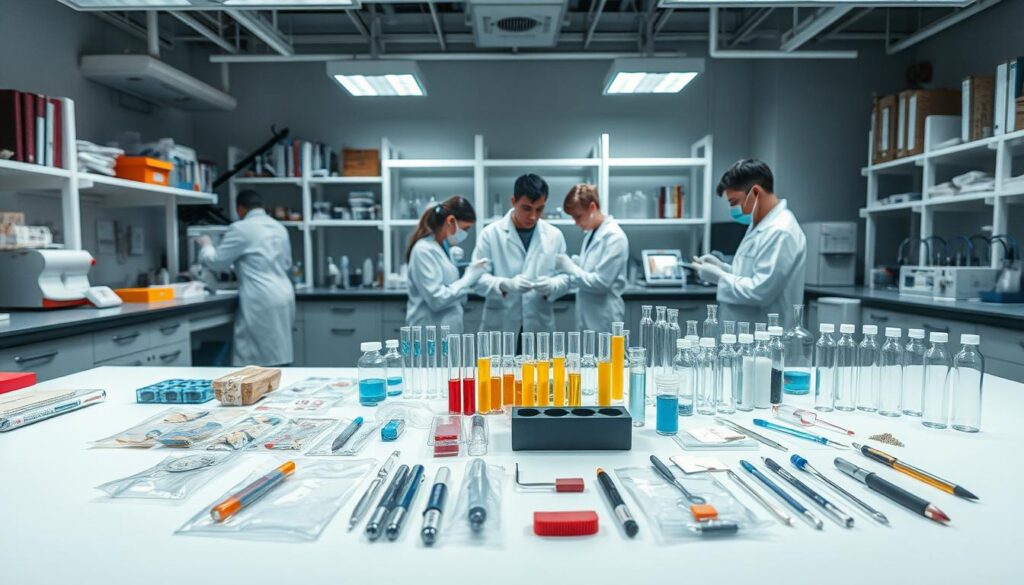
Today’s forensic analysis uses advanced techniques. These steps are crucial:
- Systematic evidence preservation
- Advanced scientific analysis
- Digital data extraction
- Comprehensive documentation
Event Data Recorders (EDRs) are vital in collecting evidence. They record important data during accidents, like:
| Data Point | Information Captured |
|---|---|
| Vehicle Speed | Precise speed before and during impact |
| Braking Patterns | Brake application intensity and timing |
| Airbag Deployment | Timing and activation of safety systems |
| Seatbelt Usage | Occupant restraint system engagement |
Digital forensics has changed accident investigations. Cell phone data offers insights. Experts spend 2-4 hours on a detailed digital image. This can reveal driver behavior before the accident.
The integrity of forensic evidence is paramount in determining the true cause of fatal accidents.
Effective analysis needs teamwork. Forensic experts, law enforcement, and lawyers must work together. Each piece of evidence must be collected, documented, and analyzed carefully. This ensures a full understanding of the incident.
Accident Scene Reconstruction Techniques
Accident reconstruction is key in forensic science. It helps experts understand crash details. They use advanced tech and careful analysis to recreate crash events.
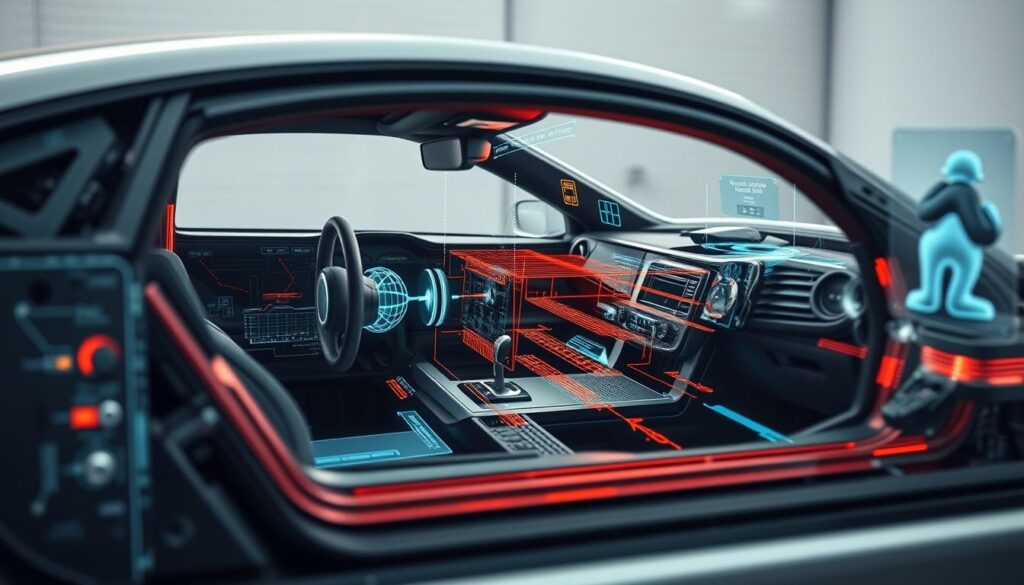
Modern crash analysis uses new techniques. These methods change how investigators document and understand accident scenes. They give deep insights into vehicle collisions.
3D Scanning and Mapping Technologies
3D scanning has changed accident reconstruction. Experts use tools like LiDAR sensors and high-resolution laser scanners. These tools capture scene details with great precision:
- Capture millimeter-level spatial measurements
- Generate comprehensive digital scene representations
- Preserve critical evidence with unprecedented accuracy
- Enable virtual scene reconstruction for analysis
Timeline Development Strategies
Creating an accurate timeline is key in crash analysis. Investigators use many data sources to rebuild the sequence of events:
- Analyze vehicle data recorders
- Review witness statements
- Examine physical evidence
- Correlate time-stamped information
Environmental Factor Assessment
Understanding the environment is vital. Reconstructionists look at road surface, weather, and visibility. This helps explain accident dynamics.
Technological advancements have improved accident reconstruction accuracy by up to 30% compared to traditional methods.
Witness Interview Strategies
Getting accurate witness statements is key in fatal accident investigations. How you interview witnesses can greatly affect your findings. It helps you understand what happened.
Timing is everything when interviewing witnesses. Try to talk to them right after the accident. The sooner you do, the more accurate their memories will be.
- Identify potential witnesses quickly
- Create a comfortable interview environment
- Use open-ended questioning techniques
- Document statements thoroughly
For effective interviews, stay neutral and let witnesses tell their story freely. Their accounts offer fresh views that can uncover important details about the accident.
Neutral, detailed witness statements can be the linchpin in understanding the true dynamics of a fatal accident.
Remember, legal rules are important in these investigations. Always get written consent for interviews and recordings. Make sure to note down all the details about the weather, driver actions, and anything else that might have played a role in the accident.
Experts know that witness statements are crucial in piecing together what happened before a fatal accident. Your careful method can reveal insights that physical evidence alone might miss.
Vehicle Dynamics and Impact Analysis
Crash analysis needs a deep look into vehicle dynamics to understand car accidents. It uses precise scientific methods to figure out what happens during a crash.
Today, advanced tech and forensic methods help recreate accidents with great detail. Investigators use special tools to gather data on what happened before, during, and after a crash.
Collision Physics Assessment
Many factors are important when studying vehicle dynamics:
- Speed at the time of impact
- Force during the crash
- Momentum transfer between cars
- Kinetic energy changes
Vehicle Data Recovery Methods
Event Data Recorders (EDRs) give key insights into crashes. These “black boxes” record important info:
- Speed before the crash
- When brakes were applied
- Steering wheel angle
- Airbag deployment data
Damage Pattern Interpretation
Forensic experts study damage patterns to understand accidents. Certain patterns show important details about the crash, like the impact angle and force.
Accurate vehicle dynamics analysis can be the key to understanding the true narrative of a fatal accident.
Human Factors in Fatal Accidents
Understanding human factors is key in fatal accident investigations. Each accident has a complex story of human actions, decisions, and system interactions. Your skill in analyzing these elements can prevent future tragedies or repeat past mistakes.
The Human Factors Analysis and Classification System (HFACS) offers a detailed framework for accident investigations. It looks at how human behavior contributes to accidents. By studying these behaviors, investigators can find deep causes beyond simple explanations.
- Psychological factors affecting performance
- Cognitive decision-making processes
- Organizational culture influences
- Individual skill and competence levels
Consider the 1977 Los Rodeos Airport collision, which killed 583 people. It showed how bad communication and decisions can cause huge disasters. This event highlights the need to understand human actions in complex systems.
Effective investigation requires looking beyond individual errors to understand systemic challenges that enable human mistakes.
Key areas of human factors analysis include:
- Fatigue and mental exhaustion
- Communication breakdowns
- Stress management
- Situational awareness
| Human Factor Category | Potential Impact |
|---|---|
| Cognitive Errors | Misinterpretation of critical information |
| Performance Limitations | Reduced reaction time and decision quality |
| Organizational Influences | Systemic pressure affecting individual choices |
Successful fatal accident investigation needs a complete approach to human factors. By using detailed analysis, you can gain insights that stop future incidents and improve safety.
Injury Biomechanics Assessment
Understanding injury biomechanics is key in accident investigations. This field looks at how forces affect the body during accidents. It helps figure out what caused the accident and who might be at fault.
Collecting forensic evidence is crucial in this field. Investigators must document and analyze injury mechanics. This helps understand where and how injuries happened.
Trauma Pattern Analysis
Trauma pattern analysis is all about studying injury mechanisms. It involves:
- Mapping force trajectories
- Identifying impact zones
- Calculating energy transfer
- Assessing tissue damage characteristics
Injury Causation Determination
To figure out injury causes, you need a detailed approach. This includes:
- Analyzing accident scene physics
- Reviewing medical records
- Simulating injury scenarios
- Using biomechanical models
| Injury Type | Biomechanical Factors | Investigation Focus |
|---|---|---|
| Blunt Force Trauma | Impact velocity, surface area | Energy transfer dynamics |
| Soft Tissue Injury | Compression, shear forces | Tissue deformation mechanisms |
| Skeletal Fractures | Stress distribution, loading rates | Bone structural integrity |
Medical Evidence Review
Reviewing medical evidence needs teamwork with forensic pathologists and medical experts. Your goal is to link biomechanical findings with medical observations. This helps fully understand injury mechanisms.
Precision in injury biomechanics assessment can transform complex accident investigations into clear, scientifically supported narratives.
Post-Collision Investigation Procedures
When we investigate fatal accidents, the steps after the crash are key. We need to look at everything carefully. This helps us understand what happened.
- Emergency response evaluation
- Vehicle extrication assessment
- Survival system analysis
- Evidence preservation
“Thorough post-collision investigation can transform tragic events into opportunities for preventing future accidents.”
There are many steps in this investigation. Forensic experts look at:
- First responder actions
- Medical personnel interventions
- Potential secondary incident factors
Today, we use digital tools and advanced analysis. About 70% of accident claims get better with an investigator at the scene.
| Investigation Element | Critical Factors | Impact Percentage |
|---|---|---|
| Emergency Response | Response Time | 45% |
| Vehicle Extrication | Rescue Techniques | 30% |
| Evidence Collection | Forensic Documentation | 25% |
Your strategy should focus on collecting all evidence. This way, you miss nothing important. By documenting everything, you build a strong base for understanding the accident.
Documentation and Report Writing
Creating a detailed scene documentation report is key in fatal accident investigations. Your skill in making a clear, precise, and legally sound document is crucial. It greatly affects how complex incidents are understood and solved.
Good documentation needs a structured method. It should capture important details while keeping a professional tone. Your report should offer a clear story that supports deep analysis and legal actions.
Report Structure Guidelines
A solid fatal accident investigation report has several parts:
- Executive summary
- Incident background
- Methodology of investigation
- Detailed findings
- Root cause analysis
- Recommendations
Evidence Documentation Standards
Keeping strict evidence documentation standards is essential. Your report must show clear, verifiable facts. These facts should stand up to checks from legal and technical experts.
| Evidence Type | Documentation Requirements | Verification Method |
|---|---|---|
| Physical Evidence | Photographic documentation | Chain of custody log |
| Digital Records | Timestamped screenshots | Forensic data extraction |
| Witness Statements | Signed, dated transcripts | Cross-referencing |
Expert Opinion Formulation
Your expert opinions should be based on solid analysis. Use data to back your points and avoid guessing. About 90% of detailed incident reports include witness statements. This makes your findings more reliable.
Precision in reporting turns raw data into useful insights that can stop future incidents.
Effective scene documentation is more than just recording events. It’s about making a clear, detailed story. This story supports safety improvements and legal understanding.
Analysis of Contributing Factors
In fatal accident investigations, understanding the causes is key. Random forest methods show 11 important factors, like land use and lighting, that lead to crashes. By looking at these, investigators can find out why accidents happen.
Your work will look at many factors that might have caused the accident. The Fatality Analysis Reporting System (FARS) data shows local drivers are often involved in wrong-way crashes. This shows how important it is to study driver actions, the environment, and other factors.
Technology is vital in today’s accident investigations. Black box data tells us what drivers did before a crash. With physical evidence like skid marks, it helps us understand what happened. This knowledge helps prevent future accidents by finding the main causes.
Dealing with fatal accidents needs a careful and detailed approach. With many miles driven every day, the risk of serious accidents is always there. Your detailed look into what caused the accident can lead to safer roads and fewer tragedies.

